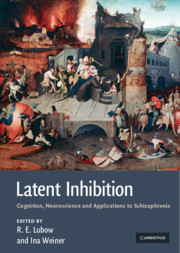Book contents
- Frontmatter
- Contents
- List of contributors
- Preface
- 1 A short history of latent inhibition research
- Current topics in latent inhibition research
- 2 Latent inhibition and extinction: their signature phenomena and the role of prediction error
- 3 Inter-stage context and time as determinants of latent inhibition
- 4 Latent inhibition: acquisition or performance deficit?
- 5 Latent inhibition and learned irrelevance in human contingency learning
- 6 Associative and nonassociative processes in latent inhibition: an elaboration of the Pearce–Hall model
- 7 From latent inhibition to retrospective revaluation: an attentional-associative model
- 8 Latent inhibition and habituation: evaluation of an associative analysis
- 9 Latent inhibition and creativity
- 10 The phylogenetic distribution of latent inhibition
- 11 The genetics of latent inhibition: studies of inbred and mutant mice
- 12 A comparison of mechanisms underlying the CS–US association and the CS–nothing association
- 13 The pharmacology of latent inhibition and its relevance to schizophrenia
- 14 Parahippocampal region–dopaminergic neuron relationships in latent inhibition
- 15 Latent inhibition and other salience modulation effects: same neural substrates?
- 16 What the brain teaches us about latent inhibition (LI): the neural substrates of the expression and prevention of LI
- 17 Latent inhibition in schizophrenia and schizotypy: a review of the empirical literature
- 18 A cautionary note about latent inhibition in schizophrenia: are we ignoring relevant information?
- 19 Latent inhibition as a function of anxiety and stress: implications for schizophrenia
- 20 Nicotinic modulation of attentional deficits in schizophrenia
- 21 Latent inhibition and schizophrenia: the ins and outs of context
- Summary and conclusions
- Index
- References
7 - From latent inhibition to retrospective revaluation: an attentional-associative model
from Current topics in latent inhibition research
Published online by Cambridge University Press: 04 August 2010
- Frontmatter
- Contents
- List of contributors
- Preface
- 1 A short history of latent inhibition research
- Current topics in latent inhibition research
- 2 Latent inhibition and extinction: their signature phenomena and the role of prediction error
- 3 Inter-stage context and time as determinants of latent inhibition
- 4 Latent inhibition: acquisition or performance deficit?
- 5 Latent inhibition and learned irrelevance in human contingency learning
- 6 Associative and nonassociative processes in latent inhibition: an elaboration of the Pearce–Hall model
- 7 From latent inhibition to retrospective revaluation: an attentional-associative model
- 8 Latent inhibition and habituation: evaluation of an associative analysis
- 9 Latent inhibition and creativity
- 10 The phylogenetic distribution of latent inhibition
- 11 The genetics of latent inhibition: studies of inbred and mutant mice
- 12 A comparison of mechanisms underlying the CS–US association and the CS–nothing association
- 13 The pharmacology of latent inhibition and its relevance to schizophrenia
- 14 Parahippocampal region–dopaminergic neuron relationships in latent inhibition
- 15 Latent inhibition and other salience modulation effects: same neural substrates?
- 16 What the brain teaches us about latent inhibition (LI): the neural substrates of the expression and prevention of LI
- 17 Latent inhibition in schizophrenia and schizotypy: a review of the empirical literature
- 18 A cautionary note about latent inhibition in schizophrenia: are we ignoring relevant information?
- 19 Latent inhibition as a function of anxiety and stress: implications for schizophrenia
- 20 Nicotinic modulation of attentional deficits in schizophrenia
- 21 Latent inhibition and schizophrenia: the ins and outs of context
- Summary and conclusions
- Index
- References
Summary
This chapter summarizes my work with Jeffrey Gray (1934–2004) on latent inhibition (LI), i.e., the retardation in the generation of the conditioned response (CR) during the pairing of the conditioned stimulus (CS) and the unconditioned stimulus (US) following CS preexposure. From 1996 to 2004, we published a series of articles on (a) a neural network model that describes LI and other classical conditioning paradigms (Schmajuk, Lam, & Gray,1996), (b) the mapping of variables in the model onto brain structures and neurotransmitters (Schmajuk, Cox, & Gray, 2001; Schmajuk, Gray, & Larrauri, 2005), (c) the application of the model to the description of the effect of brain lesions and drug administration on LI and the characterization of the neural activity and neurotransmitter release in different brain areas during LI (Buhusi, Gray, & Schmajuk, 1998; Schmajuk, Buhusi, & Gray, 1998), and (d) how the absence of LI, regarded as a positive symptom of schizophrenia, is caused by hippocampal dysfunction and ameliorated by DA blockers (Schmajuk, Christiansen, & Cox, 2000; Schmajuk, 2001; Schmajuk, 2002).
After 2004, still guided by Jeffrey's suggestions, Jose Larrauri and I (Schmajuk & Larrauri, 2006) successfully applied the model to data that seem to challenge the power of existing models of classical conditioning. Namely, recovery from blocking (the reduced responding to one CS of a conditioned compound when the other CS was separately conditioned first), backward blocking (the reduced responding to one CS of a conditioned compound when the other CS was separately conditioned following compound conditioning), the counteraction between LI and overshadowing (the reduced responding to one or both CSs of a conditioned compound compared with their individual conditioning), and super LI (decreased responding to a preexposed CS after a delay following conditioning,).
- Type
- Chapter
- Information
- Latent InhibitionCognition, Neuroscience and Applications to Schizophrenia, pp. 137 - 162Publisher: Cambridge University PressPrint publication year: 2010



